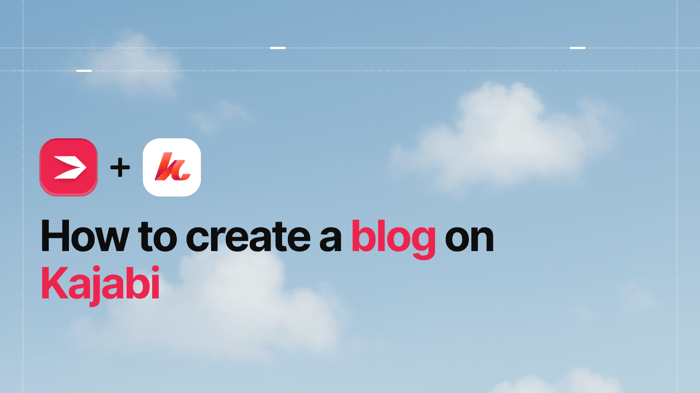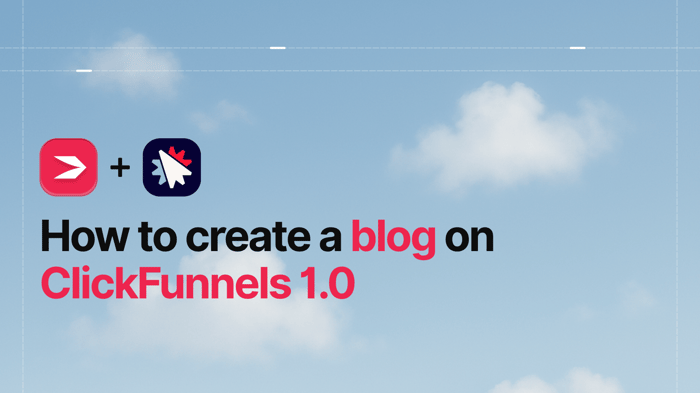A Kajabi vs. ClickFunnels comparison is not an apples-to-apples comparison. Even though they may resemble each other at a glance, Kajabi and ClickFunnels are far from being the same type of platform.

Kajabi refers to itself as an all-in-one online course platform with a focus on online education, or more precisely, course and coaching program creation. It works exclusively in the digital product realm: courses, podcasts, coaching programs, memberships, e-books, and so on are the products that you can create and sell on Kajabi.

On the other hand, as it’s widely known and accepted, ClickFunnels is primarily concentrated on sales funnels, and it’s one of the authorities in this niche. Unlike Kajabi, ClickFunnels enables you to promote and sell both digital and physical products. Even though some consider it an all-in-one business management platform similar to Kajabi, in reality, ClickFunnels is simply a premium sales funnel builder with added extra functionality. It doesn’t offer nearly as many disparate tools as Kajabi, nor does it strive to cover all the domains that Kajabi covers.
This is why here we’ll focus only on those aspects that make sense to compare in the Kajabi vs. ClickFunnels context. This means functionalities that are not just common but are also important to both platforms. Even if something doesn’t have the same weight in both places, it needs to be among their top priorities to make the comparison fair and meaningful. Any other type of Kajabi vs. ClickFunnels comparison would be flawed. So, now we’re ready to start our Kajabi vs. ClickFunnels comparison.
Table of Contents
General Notes on Kajabi vs. ClickFunnels
Kajabi and ClickFunnels are two platforms that can’t function as substitutes for each other, period. Although similar in certain aspects, they’re quite different, so choosing between the two is not like choosing to play basketball with a Wilson ball or a Spalding ball. Rather, it’s more like choosing whether to play basketball or volleyball.
In this section, we’ll try to show just how different they are and give you some examples of cases in which each is suitable as well as their respective target groups.
Courses and Coaching
So many things in Kajabi indicate that this platform caters primarily to people who work in the knowledge commerce niche. In line with that, it appears that the majority of users who opt for Kajabi work in the coaching and course creation fields, as this study suggests.
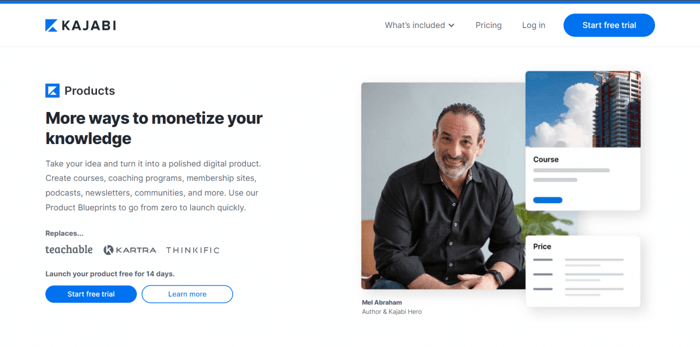
Based on this, we can say that Kajabi is, above all, a course and coaching program creation platform. However, since it offers many other functionalities, entrepreneurs love it for its versatility. It allows them to take advantage of other opportunities to support their course/coaching business and promote their products/services better through their Kajabi-built websites, landing pages, marketing emails, etc.
Unlike Kajabi, ClickFunnels’ focus is not on the knowledge commerce area, at least not directly. This platform can be relevant for online educators, coaches, and course creators, but not as a digital product builder. Its relevance springs from its capabilities as a funnel builder that allows you to promote your business, regardless of what kind of business it is. And that’s where ClickFunnels’ focus is – sales and marketing funnels, not course creation and online coaching.
Simply put, ClickFunnels doesn’t cater to e-knowledge entrepreneurs – there are no ready-made course templates, video hosting capabilities, or for that matter, anything else that could help you create a course conveniently. It can help you sell your courses, but only after you build them somewhere else.
Websites
Website creation is another area where it wouldn’t make a lot of sense to compare Kajabi to ClickFunnels. Why? Because even though ClickFunnels includes a visual page builder/editor, it doesn’t function as a site builder, at least not in the traditional sense of a platform that allows you to create multi-page websites.
One of the upshots of this is that even when you manage to connect multiple pages to simulate a typical website, you’ll still need to do some extra work to create a navigation menu.
It’s different in Kajabi. A navigation menu is simply an integral part of your website. You can create a multipage website with ease, and this site can have as many or as few pages as you want. Kajabi provides you with site templates and a visual site editor that make the whole process even more convenient. In short, everything is there to speed up and streamline what once was a long and tiring process reserved only for professional web developers.
What we said about Kajabi applies to virtually any other site builder, but not to ClickFunnels. And that’s not a downside; rather, it’s an indication that this platform neither identifies itself as a site builder nor does it work that way. As a matter of fact, we read somewhere that its founder believes that you don’t need a website at all to sell and promote your products/services.
CRM
Even though ClickFunnels includes features that allow you to manage contacts and so on, you can’t use it as a CRM system. However, the most important thing to keep in mind is that ClickFunnels doesn’t pretend or strive to be a CRM. Its interests and preoccupations are elsewhere, as we already stated, and we’ll touch on that in more detail a bit later.
Kajabi, on the other hand, does include CRM functionality. It’s not a fully-featured advanced CRM system like, say, Salesforce, but it offers multiple features, such as:
- Automated customer interactions
- Customer segmentation and filtering
- Customer tracking
Kajabi is not a replacement for a robust CRM-specialized platform, but the features it offers make it suitable for managing your clients and building high-quality customer relationships. If your business doesn’t require advanced and sophisticated CRM functions, Kajabi is more than capable of handling the customer relationship side of your business.
Conclusion
We hope that this was sufficient to show you how different Kajabi and ClickFunnels are, what the best way is (in our opinion) to approach a Kajabi vs. ClickFunnels comparison, and who these platforms primarily cater to. The rest of this comparison will tackle different topics, but what we said in this section will be threaded throughout the entire article.
Price
Instead of going over each platform’s pricing plans in two separate subsections, we’ll take a different route here. We’ll start with an outline of Kajabi’s and ClickFunnels’ pricing plans. After that, we’ll compare the lowest-tier plans’ main features head-to-head, and then continue with the next tier. That way, you’ll be able to gain a clearer picture of how Kajabi and ClickFunnels compare to each other at approximately the same pricing levels.
Pricing Plans
Kajabi
Kajabi offers three pricing plans:
- Basic: $149/month (monthly subscription) or $119/month (annual subscription)
- Growth: $199/month (monthly subscription) or $159/month (annual subscription)
- Pro: $399/month (monthly subscription) or $319/month (annual subscription)
ClickFunnels
Until recently, the ClickFunnels pricing system consisted of three pricing plans, but it looks like it no longer offers what used to be its highest-tier plan with the wordy name Two Comma ClubX and a very steep price of $2,497/month. The two current pricing plans are the following:
- Basic (a.k.a. simply ClickFunnels): $97/month (monthly subscription) or $80/month (annual subscription)
- Platinum: $297/month (monthly subscription) or $247/month (annual subscription)
Basic Plans
The Kajabi Basic Plan Features
The following are the most important features of Kajabi’s Basic plan:

The ClickFunnels Basic Plan Features
The following is a list of the features you’ll find in ClickFunnels’ Basic plan:
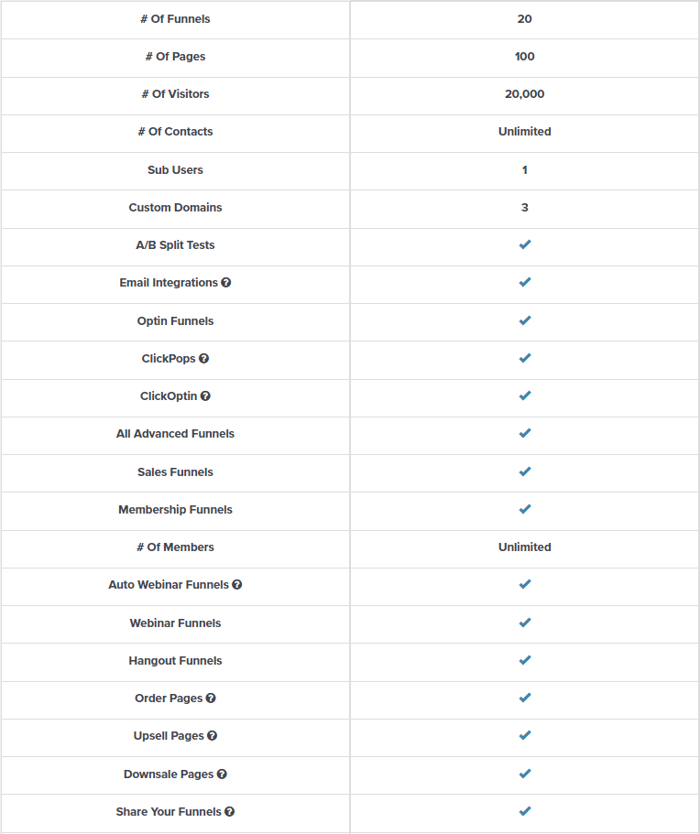
Price vs. Cost-Effectiveness
For starters, if we compare the prices – Kajabi $149, ClickFunnels $97 – it’s a noticeable difference in favor of ClickFunnels. However, in addition to the price, cost-effectiveness should also be considered when deciding what online business management solution to choose. The cost-to-value ratio may be better in Kajabi despite it being the more expensive platform.
Unfortunately, cost-effectiveness is a bit harder to determine because it depends on so many factors. Nonetheless, one thing is certain: we need to look at the features of both pricing plans to get a feeling of which one offers better value for the money.
Number of Features
You might be tempted to make inferences based on the number of features, but bear in mind that neither one of the lists you could see in the images above is complete. Also, upon closer inspection, you’ll notice that the ClickFunnels features are significantly different from what Kajabi offers. In addition to this, many of them are more or less variations on the theme of funnel.
What Makes ClickFunnels Better or Worse than Kajabi?
What really sticks out in ClickFunnels is the built-in ability to do A/B split tests. This is a feature that Kajabi lacks (although there are ways to bypass this issue), and it can give the upper hand to ClickFunnels over Kajabi in the eyes of many online business owners and enthusiasts.
On the flip side, the real pain point of ClickFunnels’s Basic plan is that it doesn’t include email marketing capabilities, which is a shame for such a popular sales and marketing platform. You’d rarely find an unbiased review on ClickFunnels that doesn’t complain about this downside. In ClickFunnels, email marketing features are available with the Platinum plan ($297/month). In contrast, Kajabi’s Basic plan includes unlimited marketing emails, which can be a life-saver for many online entrepreneurs.
Different Priorities
Looking at the rest of the features from the two lists above, we can notice differences in quantities included for certain features, but above all, differences in priorities. Even the lowest-tier plans clarify that Kajabi and ClickFunnels prioritize different qualities and cater to different audiences.
If you need funnels, then opting for ClickFunnels should be a no-brainer. On the other hand, if you need a more versatile platform that lets you create digital products but gives you the possibility to build funnels as well (“pipelines” in Kajabi’s vocabulary), then Kajabi is your friend.
Cost-Effectiveness
As far as cost-effectiveness is concerned, we think that, generally speaking, Kajabi performs better than ClickFunnels. The reason is that it’s much more versatile and, despite the higher price of Kajabi’s Basic plan, it can actually save you money.
With ClickFunnels, if you need more than a funnel builder, you’ll have to pay for a couple more apps to get access to a set of well-developed functionalities that are more or less already available in Kajabi. Considering how much it can cost to pay multiple fees for different apps on a monthly basis, Kajabi can turn out to be the more affordable and cost-effective business management solution compared to ClickFunnels.
The Standard Plans
The Kajabi Growth Plan Features
The Kajabi Growth plan offers the following features:
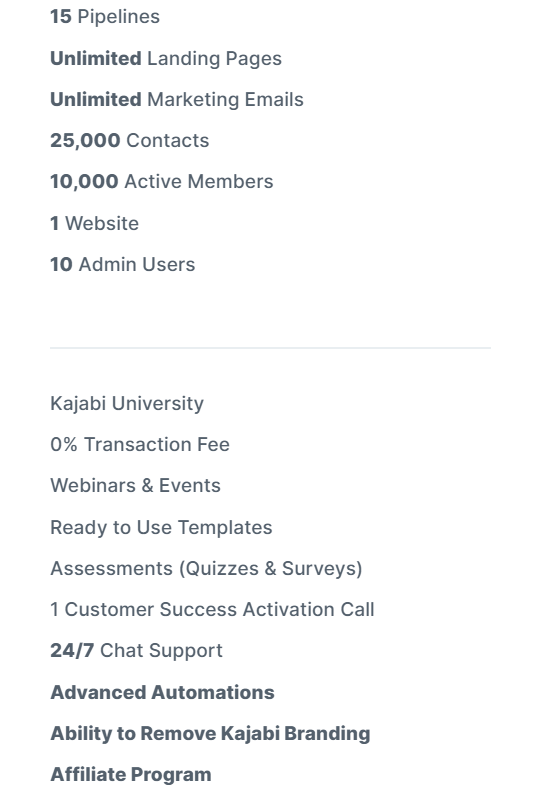
The ClickFunnels Platinum Plan Features
As far as the ClickFunnels’ Platinum plan is concerned, it’s a pretty long list of features, so here we’ll show you only the features that are unique for this plan and are absent from the Basic plan. This is how the list of unique Platinum features looks:
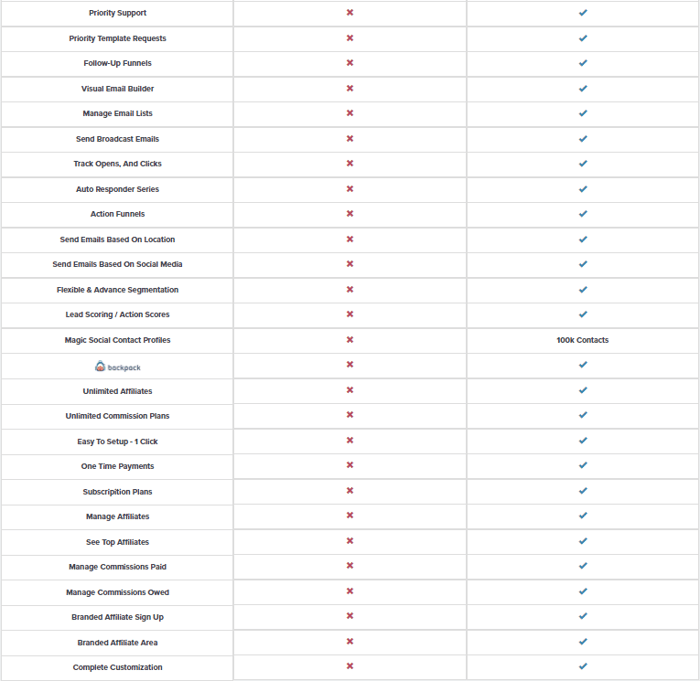
It’s pretty long, isn’t it? Unlike ClickFunnels, Kajabi takes a more modest approach; hence, the shorter list of features that we saw.
Prices and New Features
This time, the difference in prices is almost a hundred dollars, and it’s Kajabi that has the lower price, and hence the advantage ($199 as opposed to $297).
Apart from the larger quantities of the same features found in the Basic plan, with the Growth plan, Kajabi introduces a few really important novelties:
- Advanced automations.
- An affiliate program.
- A possibility to remove the Kajabi branding, which is essential for anyone who wants to build a strong brand.
In ClickFunnels’ Platinum plan, the many newly-added features come down to the following notable changes:
- A host of email marketing options.
- A ton of affiliate program options.
- An ability to offer different subscription plans to your customers.
- Complete customization, meaning freedom to add custom code.
The Best and Worst Sides of the Kajabi Growth Plan
The affiliate program Kajabi introduces on this pricing level is pretty solid, and it equips you with many analytics tools to track different aspects of your affiliates’ activities. On top of this, with Kajabi’s branding removed from your Kajabi website and pages, you’ll have a chance to build a much stronger position as a unique brand in today’s world of fierce competition.
Also, when considering this Kajabi plan, take into account that for a fairly low price, you get access to so many diverse possibilities: from creating a website to building your own affiliate program.
On the downside, the number of websites remains unchanged, which is surprising considering that there’s a significant increase in the number of everything else.
The Best and Worst Sides of the ClickFunnels Platinum Plan
With the Platinum plan, ClickFunnels makes a compelling argument for every entrepreneur who wants to have a plethora of choices regarding funnel creation, email marketing, and affiliate program building.
The features ClickFunnels introduces on this pricing level are a huge jump compared to the Basic plan. However, these perks come at a pretty big price jump as well, which can be a problem for some users.
All in all, the ClickFunnels Platinum plan is a pretty appealing offering, with the only possible downside being its price.
So, Which One Is Better – Kajabi or ClickFunnels?
The most important question here is which one do you need: a platform that allows you to do various things in one place or a platform that shares its expertise in sales and marketing funnel-building with you?
The next crucial question is: regardless of the value for money of the ClickFunnels Platinum plan, can you afford to pay that much for a sales and marketing funnel builder, knowing that you may need to pay for a couple of other apps as well?
The better fit for your business needs will ultimately depend on the answers to these questions.
Pipelines and Funnels
Despite ClickFunnels being the funnel expert here, it does make sense to compare it to Kajabi in this domain. Kajabi’s funnel-building capabilities are actually pretty decent, and they play an important role in its system. So, let’s see what this platform offers and how it compares to ClickFunnels.
Kajabi
What Are Pipelines?
Pipelines are Kajabi’s counterpart to ClickFunnels’ sales and marketing funnels. Essentially, they’re sales and marketing automations in action. This is how a pipeline looks in Kajabi:
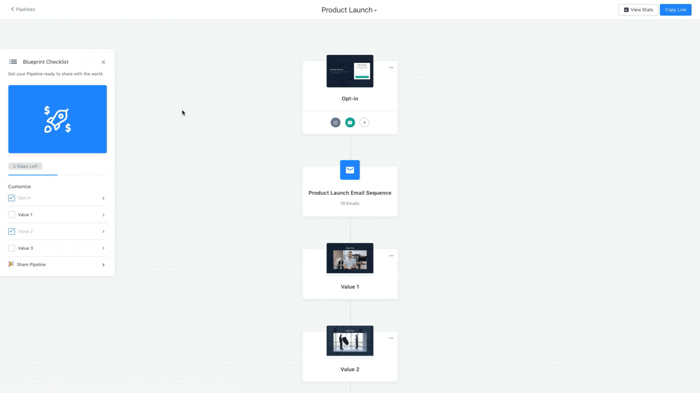
Basically, a pipeline is nothing more than a sequence of landing pages and automated email marketing campaigns, as Kajabi says, strung together to persuade a lead to become a customer.
Building a Pipeline and Pipeline Blueprints
Kajabi allows you to create a pipeline from your admin dashboard. It’s a quick and easy-to-understand process that doesn’t require technical knowledge and background.
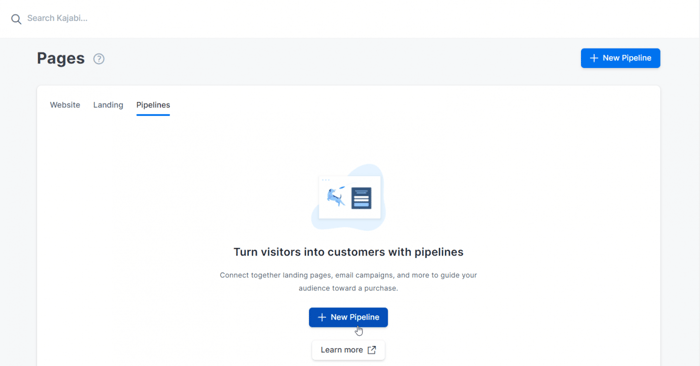
When you’re creating a pipeline, Kajabi gives you suggestions and tips on how to make use of the different steps of a pipeline, which is extremely convenient and makes the whole process of building a pipeline even faster.
However, this process wouldn’t be that convenient if you had to start from scratch every time you create a new pipeline. Luckily, Kajabi provides you with pre-built customizable pipeline blueprints (also known as frameworks) that can give you a significant headstart over anyone building pipelines from zero. Think of them as a sort of elaborate funnel templates. This is what they look like:

Keep in mind that these are not just random blueprints. They’re optimized for lead nurturing and conversion. So, thanks to them, the only thing you need to do when building a new pipeline is to add suitable content; Kajabi takes care of all the rest and does the heavy lifting for you.
There are six types of pipeline blueprints to choose from, depending on the occasion:
- Freebie: best for email list growth.
- Sales page: perfectly suitable for lead generation.
- Product launch: the name, pretty much, says it all.
- Zoom webinar: great for business owners who want to promote their products through information webinars and, as Kajabi says, “pitch their offer at the end.”
- Free book: ideal for giving away a book as a lead magnet.
- Coaching campaign: suitable for online coaches to have success with scheduling an initial call.
Customization
The landing pages can be customized in the Kajabi visual editor in line with your brand. Keep in mind that the Kajabi editor is not drag-and-drop. Some customers feel like it’s a bit clunky and not as intuitive as drag-and-drop editors. Nonetheless, editing the pre-built landing pages is far from being complex, and you’ll probably get used to the editor in no time.
To edit any part of a pipeline page, just click on it, and Kajabi will show you all the available customization options, just like in the following image:

Additional Pipeline Features
In addition to customizing pages, Kajabi also allows you to:
- Add new pages to your pipelines.
- Rearrange existing pages.
- Clone existing pages to speed the process of building a new pipeline even more.
- Share a built pipeline via a pipeline link.
- Follow pipeline stats, etc.
ClickFunnels
When it comes to funnels, ClickFunnels is hands down one of the best in the business. So, again, if you strictly need a quality funnel builder, ClickFunnels is a great solution. This platform may not have the most modern look and all the diverse tools that Kajabi has, but as a funnel builder, Kajabi is no match for ClickFunnels.
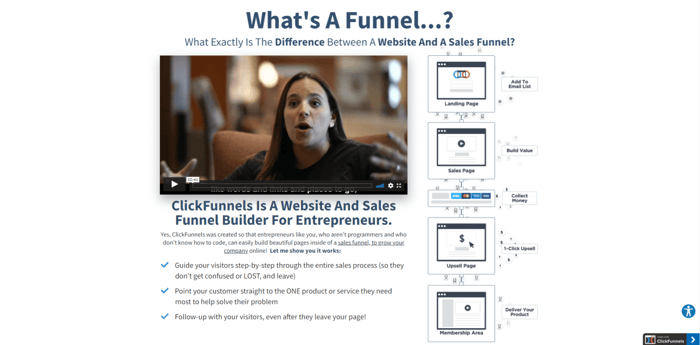
Funnel Templates
Just like Kajabi, ClickFunnels offers pre-built customizable funnels, i.e., funnel templates. Unlike Kajabi, you can find tons of them, mostly on the ClickFunnels Marketplace. Some are free, others are paid, but you can also connect with one of the ClickFunnels experts and ask for a custom-designed funnel.

As this image shows, there are a host of different categories of templates to choose from. When looking for a funnel template, you can filter your search based on whether you need the newest, bestselling, top-rated, cheapest, or most expensive templates.
In addition to the ClickFunnels marketplace, you’ll find pre-built templates in the platform’s admin dashboard:
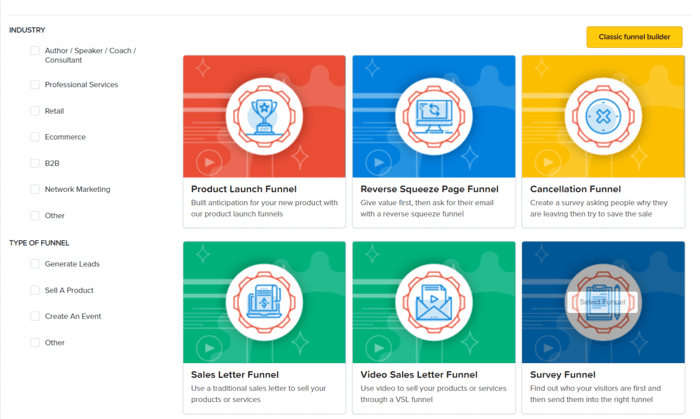
Creating a Funnel
Creating a new funnel in ClickFunnels is pretty easy. In your admin dashboard, hover over “ClickFunnels,” then click “Funnels,” and finally click the big blue “Build a New Funnel” button. After that, ClickFunnels will ask you to choose the goal of your funnel, its type, etc.
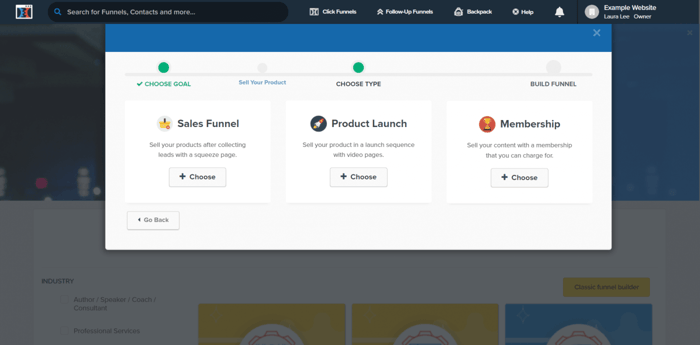
Alternatively, you can choose to build a custom funnel, which will allow you to skip over these steps and go right to the part where you give your funnel a name and a group tag (the class of funnels it will fall under). Whichever you choose, you’ll end on a page where you can select a funnel page template and add new steps to your funnel.
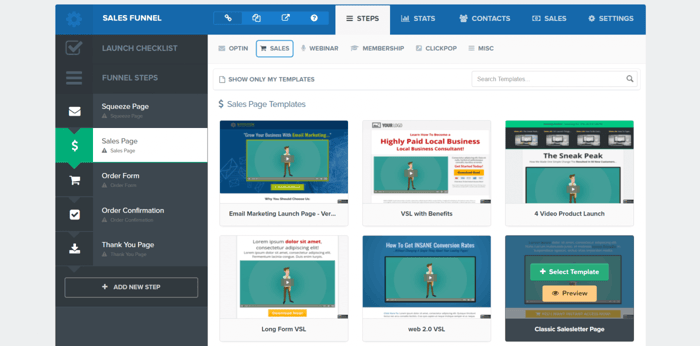
The ClickFunnels Editor
Unlike Kajabi, the ClickFunnels editor is a drag-and-drop editor, and we have to say it’s more intuitive and easy to use; it just feels better when you start working in it.

The drag-and-drop editor is one of the most beloved aspects of ClickFunnels, and many users report enjoying using it to build and edit their funnels. This can be a huge plus for this platform regardless of what other platform we compare it to. So, keep in mind that if an intuitive, simple, yet powerful editor is what you’re after, you’ll like what ClickFunnels has to offer in this realm.
Features
Countless features deserve to be mentioned in this section. However, we’ll have to limit ourselves to only a few of the most basic ones. So, the following are some of the funnel-related functions available on ClickFunnels:
- An ability to duplicate a funnel.
- An ability to automate and customize your email notifications.
- An ability to set up an abandoned cart email.
- An ability to restore deleted funnel steps.
- An ability to view and filter funnel-related stats, etc.
Verdict
Even after providing all the context we’ll ever need, the verdict is straightforward: Kajabi works pretty well as a funnel builder, but ClickFunnels really excels in this area, so it definitely has the upper hand over Kajabi.
The main difference between the two platforms is that ClickFunnels offers an extremely wide range of options that you won’t find in Kajabi. This makes it an excellent solution for someone who has built a good-functioning business management system but lacks the software that takes funnel building to the next level. In contrast, Kajabi would work best for someone whose requirements regarding funnels are much more basic.
Integrations
It’s almost impossible to find a business management solution that’s absolutely self-sufficient. That’s why contemporary web platforms include either an app store or offer at least some integration possibilities to their customers.
Kajabi
Official Integrations
Kajabi has a separate integrations page on its website where you can find all the official integrations available for installation on this platform. There are not many of them. There are 17 apps listed on the integrations page, and they fall under five categories:
- Email marketing
- Member experience
- Sales and conversions
- Analytics
- Other (basically, the category includes two scheduling apps)
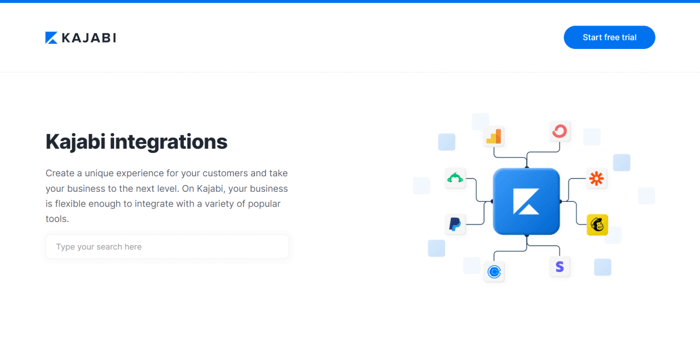
The list of official Kajabi integrations includes prominent names, such as:
- Stripe and PayPal (payment processing)
- ActiveCampaign and ConvertKit (email marketing and automation)
- Google Analytics and Facebook Pixel (analytics and reporting)
- Calendly (scheduling)
- Zapier (integration tool and workflow automation), etc.
More Integration Possibilities
Alternatively, Kajabi allows you to add more apps through embed codes on top of the official integrations. One example of such an app is DropInBlog – a full-featured content marketing and blogging platform. The integration process is pretty easy and quick. In a few simple steps, you’ll be able to integrate DropInBlog with Kajabi and reap the benefits of this app. For more on the integration process and how the embed code method works in practice, take a look at the brief guide on How to Create a Blog on Kajabi.
Why So Few Official Integrations?
The whole point of Kajabi being an all-in-one platform is to provide you with as many native tools in one place as possible. This implies that a large ecosystem of integrations is not quite compatible with an all-in-one platform, which explains the low number of official Kajabi integrations.
However, knowing how important it is for any entrepreneur today to have as many choices and tools at hand as possible, Kajabi provides its customers with an opportunity to integrate third-party apps as well. And as we saw, if you can’t find what you need among the official integrations, you can always check whether there’s a possibility to add a new functionality through an embed code.
ClickFunnels
The ClickFunnels Integrations
ClickFunnels has a slightly different approach to integrations. You won’t be able to find an official app store or anything along those lines on the ClickFunnels site. However, the famous funnel builder does integrate with third-party apps; you just need to look into its documentation, or more precisely its help center, to find information on what’s available.
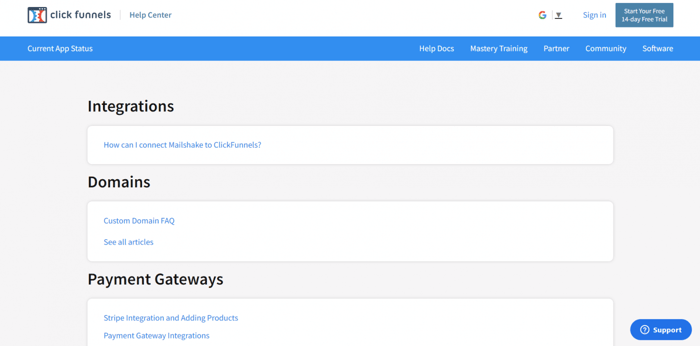
Some of the integrations that you can find information about on ClickFunnels are the following:
- Stripe (payment processing)
- Zoom (webinars and conferencing)
- ZenDirect (actions and messaging)
- Twilio (SMS)
- Shopify (e-commerce and shipping)
For more information on this topic, check out the ClickFunnels help center entries on what apps you can integrate directly with the platform as well as these articles about integration options. Also, keep in mind that this platform allows integration through embed codes as well. If you want to learn more about that, check out this article.
What Do the Customers Think?
Kajabi
When it comes to integrations on Kajabi, some customers wish there was more choice. On the other hand, many feel happy with Kajabi as it is due to it being an all-in-one platform that provides almost everything they need without having to add lots of third-party apps. Overall, most Kajabi customers feel content with how the platform and its integrations work.
ClickFunnels
As for ClickFunnels, things are a bit different. A non-negligible number of customers imply that configuring integrations in ClickFunnels is more complex and difficult than it should be and report integration issues with various third-party apps. Judging from the platform’s popularity, this can’t be the default viewpoint; but it does show up relatively frequently in customer reviews, so it’s a caveat you need to know about when considering ClickFunnels.
Customer Support
A Kajabi vs. ClickFunnels comparison would be incomplete without exploring how these two platforms perform in the customer support domain. In this section, we’ll take a look at the support options Kajabi and ClickFunnels offer and what their customers think about them.
Kajabi
Kajabi provides around-the-clock email support as well as live chat support. If you’re on the Basic plan, the chat support is available during business days from 6 a.m. to 5 p.m. PT. With the higher-tier plans, you get access to 24/7 live chat support.
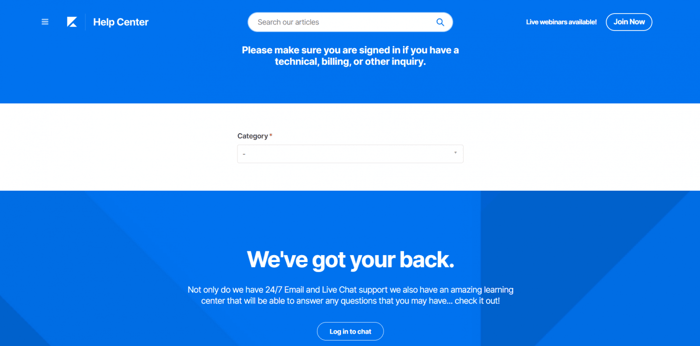
Overall, the Kajabi customer support is considered to be pretty helpful and up to the task.
ClickFunnels
ClickFunnels offers help through a ticketing system (essentially, this is email support) that you can use 24/7 to address issues and ask for help. In addition to this, the company provides around-the-clock chat support during business days to all customers, regardless of the pricing plan.
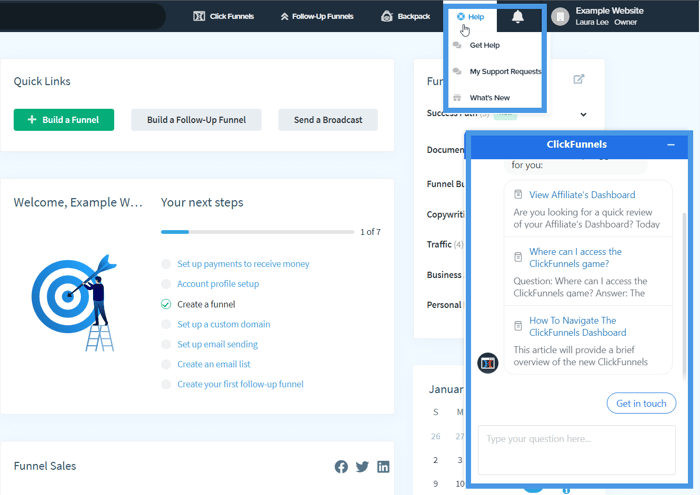
The live chat support is a relatively recent addition to ClickFunnels’ feature set. It was introduced in January 2021. Along with the increased number of customer support staff members, it’s probably one of the main reasons why there are so many satisfied ClickFunnels customers today.
Before the platform introduced the live chat feature and brought more customer support agents to its team, its customer support service had been a target of harsh criticism and a frequent cause of customer dissatisfaction. Luckily, ClickFunnels decided to react, and all the steps it took toward improvement came to fruition, which is clearly reflected in recent customer reviews.
Verdict
We can say that Kajabi and ClickFunnels are pretty similar in this area. In addition to the similar types of direct support (email and chat), they offer a ton of learning and self-help resources (ClickFunnels being especially known for its training and learning material). Moreover, according to the majority of their customers, both provide rock-solid support. This implies that whichever you choose, chances are, you’ll get quality customer support.
Over and Out
In this Kajabi vs. ClickFunnels comparison, we argued that these two platforms have very different natures and purposes. We hope that we successfully showed what they are, what they do best, and how they perform in different areas.
To summarize, if a world-class funnel builder is primarily what you need, ClickFunnels would be a better option than Kajabi. On the other hand, if you need a platform that offers a funnel builder among many other functionalities not often found in the same place, Kajabi would be a better choice.
In the end, don’t forget that while you can’t use them as replacements for each other, you can use them both at once. Kajabi integrates easily with ClickFunnels, and the latter is part of the list of official Kajabi integrations, so making them work together should be a breeze. Pretty interesting, isn’t it?


